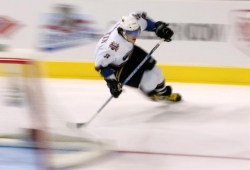In the past, I’ve proposed that speed (both on and off the ice) comes down to force application. In other words, the more force you put into the ice, the faster you skate. This understanding is important because it helps athletes (and parents and coaches) that are ONLY interested in speed understand the importance of strength training. Simply, using the transitive property of mathematics:
More Strength = More Force
More Force = More Speed
More Strength = More Speed
While there’s more to it than this, it really is THIS simple for many of the hockey players I work with. They’re simply not strong enough to skate faster than they are. They need to improve their capacity to develop speed before they can develop speed.
I recently came across a new study on sprinting performance that had some interesting results. Bret Contreras, who is about as well-read in strength and conditioning research as anyone I know, wrote a summary of the article here: Sprinting Performance is Not Solely About Force Put Into the Ground. Legendary ice hockey physiologist Jack Blatherwick wrote a more hockey-specific interpretation of the study here: Acceleration: It’s not just about strength; it’s about efficient application of strength .
You can read the abstract here: Technical Ability of Force Application as a Determinant Factor of Sprint Performance
Basically, the results of this study support the idea that the TOTAL amount of force put into the ground isn’t as important as the direction of the force. At first glance, this strikes me as one of those studies that people will misinterpret and inappropriately cite for years. “Force doesn’t matter!”. Force still matters. In fact, force is still the key; it just needs to be qualified.
In these studies, researchers can use force platforms to dissociate between force applied in vertical and horizontal orientations. Every ground-based athletic movement will involve both, but with certain movements it will be more desirable to shift a greater proportion of the force production in either a vertical or horizontal orientation. For example, a vertical jump would necessitate maximal vertical force production and minimal horizontal force production. Likewise, it is only logical that sprinting, an activity whose performance is quantified by the time it takes to cover a horizontal distance, would necessitate more force put forth in a horizontal direction than vertical.

As Blatherwick pointed out in his article, the primary finding of this study is one that track coaches (and the strength and conditioning coaches that put a premium on sprint technique) have known for years. Training to improve a player’s capacity to produce force (e.g. strength) is a necessary part of development. The important take home from this study is that movement quality cannot be overlooked, and in itself is a worthy training aim. Once QUALITY is established, then QUANTITY should be overlaid to improve capacity.
To your success,
Kevin Neeld
P.S. You can get a free copy of my hockey speed training manual “Breakaway Hockey Speed”. Just enter your name and email below!